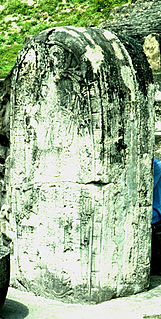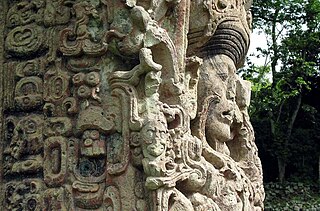Related Research Articles

The Mayan numeral system was the system to represent numbers and calendar dates in the Maya civilization. It was a vigesimal (base-20) positional numeral system. The numerals are made up of three symbols; zero, one and five. For example, thirteen is written as three dots in a horizontal row above two horizontal bars; sometimes it is also written as three vertical dots to the left of two vertical bars. With these three symbols each of the twenty vigesimal digits could be written.
A Kʼin is a part of the ancient Maya Long Count Calendar system which corresponds to one day. It is the smallest unit of Maya time to be counted as part of the long count and it usually appears as the last glyph in a long count date. Such long count dates can be seen on many inscriptions in the Mayan area at the start of the initial series which usually occurs at the beginning of an inscription.

The Maya calendar is a system of calendars used in pre-Columbian Mesoamerica and in many modern communities in the Guatemalan highlands, Veracruz, Oaxaca and Chiapas, Mexico.

Piedras Negras is the modern name for a ruined city of the pre-Columbian Maya civilization located on the north bank of the Usumacinta River in the Petén department of northeastern Guatemala. Piedras Negras is one of the most powerful of the Usumacinta ancient Maya urban centers. Occupation at Piedras Negras is known from the Late Preclassic period onward, based on dates retrieved from epigraphic information found on multiple stelae and altars at the site. Piedras Negras is an archaeological site known for its large sculptural output when compared to other ancient Maya sites. The wealth of sculpture, in conjunction with the precise chronological information associated with the lives of elites of Piedras Negras, has allowed archaeologists to reconstruct the political history of the Piedras Negras polity and its geopolitical footprint.
The 32nd century BC was a century which lasted from the year 3200 BC to 3101 BC.

Mesoamerican calendars are the calendrical systems devised and used by the pre-Columbian cultures of Mesoamerica. Besides keeping time, Mesoamerican calendars were also used in religious observances and social rituals, such as for divination.

The Dresden Codex is a Mayan book, the oldest surviving from the Americas, dating to the 13th or 14th century. The codex was rediscovered in the city of Dresden, Germany, hence the book's present name. It is located in the museum of the Saxon State Library.
A baktun is 20 katun cycles of the ancient Maya Long Count Calendar. It contains 144,000 days, equal to 394.26 tropical years. The Classic period of Maya civilization occurred during the 8th and 9th baktuns of the current calendrical cycle. The current baktun started on 13.0.0.0.0 — December 21, 2012 using the GMT correlation.
Mesoamerica, along with Mesopotamia and China, is among the three known places in the world where writing has thought to have developed independently. Mesoamerican scripts deciphered to date are a combination of logographic and syllabic values. They are often called hieroglyphs due to the iconic shapes of many of the glyphs, a pattern superficially similar to Egyptian hieroglyphs. Fifteen examples of distinct writing systems have been identified in pre-Columbian Mesoamerica, many from a single inscription. The limits of archaeological dating methods make it difficult to establish which was the earliest and hence the fore-bearer from which the others developed. The best documented and deciphered Mesoamerican writing system, and the most widely known, is the classic Maya script. An extensive Mesoamerican literature has been conserved partly in indigenous scripts and partly in the postconquest transcriptions in the Latin script.
A kʼatun is a unit of time in the Maya calendar equal to 20 tuns or 7,200 days, equivalent to 19.713 tropical years. It is the 2nd digit on the normal Maya long count date. For example, in the Maya Long Count date 12.19.13.15.12, the number 19 is the kʼatun.

The Mesoamerican Long Count calendar is a non-repeating, vigesimal (base-20) and base-18 calendar used by several pre-Columbian Mesoamerican cultures, most notably the Maya. For this reason, it is often known as the MayaLong Count calendar. Using a modified vigesimal tally, the Long Count calendar identifies a day by counting the number of days passed since a mythical creation date that corresponds to August 11, 3114 BCE in the Proleptic Gregorian calendar. The Long Count calendar was widely used on monuments.

Uxbenka is a pre-Columbian Mesoamerican archaeological site located in Belize's southernmost district of Toledo. An urban settlement of the pre-Columbian Maya, it is the earliest-known Maya polity in the southern Belizean lowlands, with evidence of occupation dating to the Early Classic period of Mesoamerican chronology. It is one of five major Maya sites in this region, whose archaeological sites also include Nim Li Punit and Lubaantun. Settlement of Uxbenka has been suggested to have occurred originally by Peten peoples. The site is approximately 40 square kilometers in size, and Uxbenka is referred to as a medium sized polity ). Uxbenka rose shortly after the expansion of another Mayan site: Tikal. The site is thought to have been first inhabited during the late Preclassic period.
"Fish-Fin" is a designation or nickname given by Mayanist epigraphers to a personage whose undeciphered name-glyph appears in the epigraphic record in association with the Emblem glyph of Bonampak, a pre-Columbian Maya civilization site in present-day Chiapas, Mexico.

The Maya civilization was a Mesoamerican civilization developed by the Maya peoples, and noted for its logosyllabic script—the most sophisticated and highly developed writing system in pre-Columbian Americas—as well as for its art, architecture, mathematics, calendar, and astronomical system. The Maya civilization developed in an area that encompasses southeastern Mexico, all of Guatemala and Belize, and the western portions of Honduras and El Salvador. This region consists of the northern lowlands encompassing the Yucatán Peninsula, and the highlands of the Sierra Madre, running from the Mexican state of Chiapas, across southern Guatemala and onwards into El Salvador, and the southern lowlands of the Pacific littoral plain.

Jasaw Chan Kʼawiil II also known as Stela 11 Ruler,, was an ajaw of the Maya city of Tikal. He ruled c.869. The monuments associated with Jasaw Chan Kʼawiil II are: Stela 11 and Altar 11.

The 2012 phenomenon was a range of eschatological beliefs that cataclysmic or otherwise transformative events would occur on or around 21 December 2012. This date was regarded as the end-date of a 5,126-year-long cycle in the Mesoamerican Long Count calendar, and as such, festivities to commemorate the date took place on 21 December 2012 in the countries that were part of the Maya civilization, with main events at Chichén Itzá in Mexico, and Tikal in Guatemala.

Maya stelae are monuments that were fashioned by the Maya civilization of ancient Mesoamerica. They consist of tall, sculpted stone shafts and are often associated with low circular stones referred to as altars, although their actual function is uncertain. Many stelae were sculpted in low relief, although plain monuments are found throughout the Maya region. The sculpting of these monuments spread throughout the Maya area during the Classic Period, and these pairings of sculpted stelae and circular altars are considered a hallmark of Classic Maya civilization. The earliest dated stela to have been found in situ in the Maya lowlands was recovered from the great city of Tikal in Guatemala. During the Classic Period almost every Maya kingdom in the southern lowlands raised stelae in its ceremonial centre.

Maya astronomy is the study of the Moon, planets, Milky Way, Sun, and other astronomical occurrences by the Precolumbian Maya Civilization of Mesoamerica. The Classic Maya in particular developed some of the most accurate pre-telescope astronomy in the world, aided by their fully developed writing system and their positional numeral system, both of which are fully indigenous to Mesoamerica. The Classic Maya understood many astronomical phenomena: for example, their estimate of the length of the synodic month was more accurate than Ptolemy's, and their calculation of the length of the tropical solar year was more accurate than that of the Spanish when the latter first arrived.
Discussions of the far future are of major importance both in theology and folk religion. Many Christian authors have welcomed the scientific theory of the heat death of the universe as the ultimate fate of the universe as it was first proposed, while atheists and materialists back then commonly opposed the theory in favour of the idea that the universe and life in it would exist eternally. Nonetheless, in modern days, nontheists have largely come to accept the theory, while Christian eschatology is in conflict with the idea that entropy will be the predominant factor in determining the state of the far future, instead predicting God's creation of the New Earth and its existence into the far future. According to Mahayana Buddhism, an emanation of the Buddha-nature will appear in the material world in the far future.

Chak Tok Ichʼaak II, also known as Jaguar Paw II and Jaguar Paw Skull, was an ajaw of the Maya city of Tikal. He took the throne c. 486 and reigned until his death. He was son of Kʼan Chitam and Lady Tzutz Nik. The monuments associated with Chak Tok Ichʼaak II are Stelae 3, 7, 15, 21, and possibly 26.
References
- Gabrielle Vail; Martha J. Macri (12 November 2012). The New Catalog of Maya Hieroglyphs, Volume Two: Codical Texts. University of Oklahoma Press. p. 154. ISBN 978-0-8061-8592-7.
The University of Oklahoma Press is the publishing arm of the University of Oklahoma. Founded in 1929 by the fifth president of the University of Oklahoma, William Bennett Bizzell, it was the first university press to be established in the American Southwest. The OU Press is one of the leading presses in the region, and is primarily known for its titles on the American West and Native Americans, though the press publishes texts on other subjects as well, ranging from wildlife to ancient languages. Tornadoes and severe weather are another focus. The press releases around 80 books every year. A profile of the University of Oklahoma Press from 2018 quotes OU President David Boren as saying: "The OU Press is one of the crown jewels of the University of Oklahoma.”

The International Standard Book Number (ISBN) is a numeric commercial book identifier which is intended to be unique. Publishers purchase ISBNs from an affiliate of the International ISBN Agency.
| This article related to indigenous Mesoamerican culture is a stub. You can help Wikipedia by expanding it. |